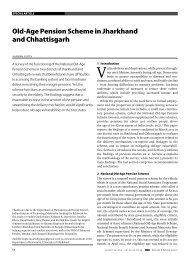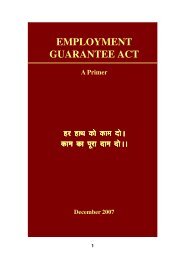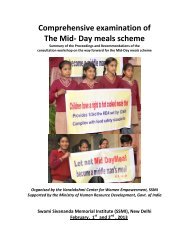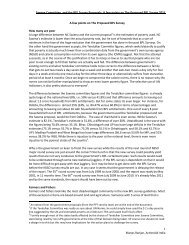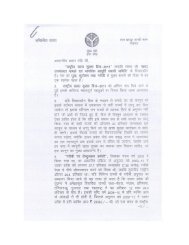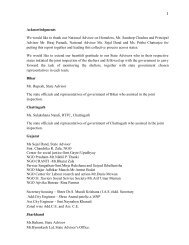NREGA: Opportunities and Challenges - Diksha
NREGA: Opportunities and Challenges - Diksha
NREGA: Opportunities and Challenges - Diksha
You also want an ePaper? Increase the reach of your titles
YUMPU automatically turns print PDFs into web optimized ePapers that Google loves.
<strong>NREGA</strong>: OPPORTUNITIES AND CHALLENGESA ‘Situation Assessment of Farmers’, done by the National Sample Survey Organisation in 2002, points torampant indebtedness of farmers in <strong>NREGA</strong> states in general, <strong>and</strong> in the <strong>NREGA</strong> districts in particular. In19 out of the 27 <strong>NREGA</strong> states, close to 49 per cent of the farmers are indebted – up from 26 per cent in1991. Significantly, the two key causes for taking loans were found to be for productive purposes: capitalexpenditure <strong>and</strong> current expenditure in agriculture. Out of every Rs 1,000 taken as loan, Rs 584 had beenborrowed for these two purposes.Given that the <strong>NREGA</strong> covers most of India’s forested areas, the contribution of this sector to localeconomy has been substantial. The <strong>NREGA</strong> districts cover close to 40 per cent of India’s very denseforests <strong>and</strong> 47 per cent of its moderately dense forests (see Table: Forest cover in sleect districts of the<strong>NREGA</strong> states). Dependence of local people on forests for survival in these districts is very high. Studiesin Orissa, Madhya Pradesh, Chhattisgarh <strong>and</strong> Jharkh<strong>and</strong> indicate that over 80 per cent of forest dwellersdepend entirely on minor forest produce; 17 per cent of l<strong>and</strong>less people depend on the daily wage labourof collecting forest produce; <strong>and</strong> 39 per cent of people are involved in minor forest produce collection assubsidiary occupation. However, forest degradation <strong>and</strong> restrictive forest laws are stripping this vital sourceof livelihood. Out of 27 states under <strong>NREGA</strong>, 13 have reported forest loss. This means 138 districts out ofthe 200 are reporting deforestation.Given these socio-economic characteristics of India’s backward districts, <strong>NREGA</strong> holds immense potentialfor their long-term development. The ‘permissible works’ under the Act have the capacity to address thepoorest districts’ key problems like l<strong>and</strong> degradation <strong>and</strong> water scarcity. Thus, for the poorest districts, the<strong>NREGA</strong> is more of a development opportunity than just creation of few daily wage jobs.Table: Forest cover in select districts of the <strong>NREGA</strong> StatesName of State Name of Geographical Total Forest Change in Total Forest % of Total ForestDistrict Area Sq. km Cover Sq. km Cover (2001-2003) Cover to State’sSq. kmGeographic AreaAndra Pradesh 171,044 28,956 -140 12.93Ananthpur 19,130 413 -98 2Ranga Reddy 7,710 392 11 5Jharkh<strong>and</strong> 67,328 18,803 -19 27.93Pakur 1,571 282 -12 18Karnataka 42,863 1,703 -244 3.97Chitradurga 8,440 445 11 5Madhya Pradesh 132,307 38,414 -858 29.03Sidhi 10,526 4,013 -81 38Tikamgarh 5048 325 -29 6.44Orissa 107,556 38,571 -47 35.85Balangir 6,575 952 -40 14Rajasthan 33,581 4,990 132 14.86Dungarpur 3,770 250 10 7Tamil Nadu 28,893 4,979 299 17.23Nagappattinam 2,140 53 -25 2Uttar Pradesh 95,722 7,403 287 44.63B<strong>and</strong>a 4,532 103 -80 2Chitakoot 3,206 36 1 0.55West Bengal 56,504 7,270 1,312 12.87Birbhum 4,545 59 0 1.30Source: State of Forest Report, Ministry of Environment <strong>and</strong> Forest, New Delhi29



